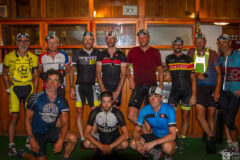Clothing can have a major effect on how comfortable you are on the bike, especially when riding long distances. Items of clothing for the contact points with the bike are covered on other pages in this section; see the list of related pages below. Other items of bike clothing are covered on this page.
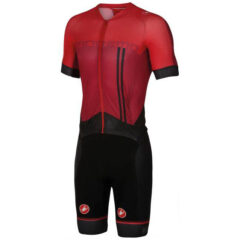
Page Contents:
- Saddle Comfort: Saddle, Shorts & Tires
- Hand Comfort: Handlebars, Aerobars & Gloves
- Foot Comfort: Shoes & Pedals
Cycling Shorts & Jerseys
How to choose shorts that work with your saddle is covered on the Saddle Comfort: Saddle, Shorts & Tires page. That page includes a discussion of the importance of hygiene and keeping your shorts clean to prevent salt and dirt from causing saddle sores. For this reason, I recommend bringing two pairs of shorts in bikepacking races so that you have a clean pair to put on each morning even if you sleep outside some nights.
Many people prefer to use cycling shorts with bib straps instead of having an elasticated waistband because they find the elastic waist uncomfortable and the bibs keep the padded insert more reliably positioned. I’ve never been a big fan of bib straps because I often notice them pulling on my shoulders, the extra material on my back is not ideal in really hot conditions, and they are more cumbersome to take on and off, but I’m also not a big fan of bib-less shorts, which do move around more.
Fortunately, it is possible to have the benefits of bib-shorts without having the disadvantages of the bib straps by using an integrated, one-piece jersey and shorts such as the Castelli SanRemo Speedsuit, Cuore Two-In-One, or Louis Garneau Course. These one-piece models are marketed as offering slightly improved aerodynamics compared to two-piece combinations, but I’ve found that their major benefit is being extremely comfortable due to not having any straps and not having an elasticated waist – they are the ultimate clothing option for ultracyclists, in my opinion.I reviewed these models in a blog post: The most comfortable cycling clothing: One-piece outfits.
These one-piece jersey and shorts comabinations are not the same as pure aero’ skinsuits. Skinsuits tend to have only a short front zipper, whereas a one-piece jersey and shorts has a full zipper so that the front can be fully opened in very hot weather, making it about the same as a regular jersey in those conditions. The full zipper also makes them easy to put on and take off, and in this aspect they actually perform slightly better than separate bib shorts and a jersey because once you take the take the top half/jersey off, the shorts come straight down. Pure skinsuits are also impractical because they have no pockets, but the one-piece jersey and shorts have rear pockets that are only slightly smaller than on most cycling jerseys (which works fine for me because I tend to avoid carrying stuff in my pockets anyway). Pure skinsuits with a short zipper are also less convenient than versions with a full zipper for males when using the toilet.
If you do choose to use separate shorts and jersey then I would recommend choosing a jersey that is lightweight and comfortable in hot weather because it is easy to put on a base layer and wind-stopping vest if necessary in cooler conditions. A more lightweight jersey will also dry faster after washing it or if you get rained on.
If you want to optimize your cycling speed then a far more effective way to do so than to remove weight from your bike or equipment is to use a jersey that is reasonably tight-fitting (see the Air Resistance of the Cyclist page and the Specialized video below). Many people like to wear a jersey made of merino wool so that they don’t smell when not washed for multiple days, but those are are not particularly aerodynamic and the thinner merino wools that are best for hotter weather are not as robust as synthetic materials.
Socks
Socks that breathe well are essential, and black is often more practical than white in a bikepacking race since they won’t stay clean for long over multiple days with minimal washing. Just like cycling shorts, I bring two pairs so that I have a clean pair each day and if one pair gets wet then I have a dry pair to put on once it’s stopped raining. As with the jersey, some people choose socks made of merino wool to avoid having them smell too much.
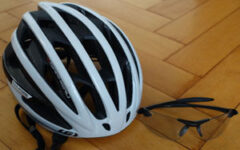
Helmet & Glasses
There are many modern helmets marketed as being more aero’ than standard road helmets, but the data suggests that the aero’ difference isn’t large and many of the more aero’ models are less well ventilated than standard road models, so the minimal gains may not be worth the disadvantages (see this BikeRadar article). I’ve found that the Louis Garneau Course (Amazon) helmet is comfortable for me and despite being designed to be aerodynamic it keeps my head as cool as most other models. The predicted effect on the speed of using such a helmet is covered on the Air Resistance of the Cyclist page.
For sunglasses, I use a model that has a photo-chromatic lens that gets darker or lighter depending on the conditions. Different models are available that cover different ranges of the lightness/darkness spectrum. I prefer models that cover the lighter end of the spectrum so that they are sufficient in the daytime (but are not that dark) while more importantly at night they block very little light. I use a model by Tifosi (Amazon), who sell many mid-priced options, but there are several other brands that offer similar products. Alternatively, you could use sunglasses with interchangeable lenses or use two pairs of glasses, but that would mean carrying more items and switching them at the end of the day, but I’ve also occasionally chosen to do that.
Clothing for All Weather
Encountering cold and/or wet weather during part of an ultracycling race is reasonably likely even in races that are held in the middle of summer; see the summaries of previous editions of The Transcontinental Race for multiple examples. Cold temperatures are particularly likely when riding in the early mornings or at higher elevations. Rain is possible anywhere, and you should also be prepared for intense heat during the summer.
What clothing is needed to continue riding in all weather to maximize your Time Efficiency varies widely for different people, so this is something that you should figure out during training. The ideal setup is to have clothing that is as versatile as possible for a variety of conditions and is compact so that it doesn’t take up too much space when not needed.
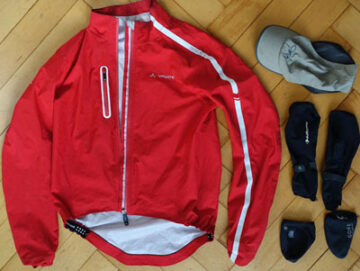
Rain
You shouldn’t expect any rain clothing to keep you totally dry in extended, heavy rain, but it should keep you dry in moderate rain and keep you warm enough to be able to keep riding in heavier rain. A waterproof jacket is a must to keep your core warm and I’ve been very pleased with the Vaude Sky Fly (Amazon), shown on the right, because it keeps out rain well, is reasonably breathable and packs down really small. If you already have a good waterproof jacket that doesn’t keep out the rain like it used to then outdoors/camping shops sell products that you can use to restore the waterproofing ability, and see the article at BikeRadar. BikeRadar also has a good article describing how waterproof clothing works and reviewing several jackets, see here.
The next most important piece of raingear for me is full-length Fenders. Not many bikepackers use them, they are far more common for touring cyclists, but they do a great job of keeping water from getting thrown up by the wheels onto the lower legs. They also keep the drivetrain a lot cleaner and for me the minor disadvantages are insignificant in comparison to their advantages.
My legs still get wet from the rain in the air, so I have a pair of waterproof overshorts, Vaude Spray (Amazon), that double as shorts that I can use when off the bike and occasionally on some really cold mornings. If you decide not to have fenders and to not bring something to cover your shorts then you may have problems with dirty water from the road spraying onto your cycling shorts. The dirt will cause extra friction that can quickly result in saddle sores, so I highly recommend having either fenders or overshorts, or both, but never neither.
Keeping the core and legs warm helps to encourage the body to keep pumping warm blood out to the extremities to keep those warm, but it’s a good idea to bring something to protect your hands and feet. The fenders help to keep my feet somewhat dry, but I also bring small Gore Road Toe Protectors (Amazon). To protect my hands, I have lightweight glove covers: RaidLight Overmitts.
I find that my vision in the rain is greatly helped by wearing a lightweight baseball cap (Outdoor Research Swift) under my helmet. This keeps the rain off of my glasses and my face, making it much safer and more pleasant to ride in such conditions and also keeps my head slightly warmer.
Cold
My cool weather gear is a lightweight pair of Craft Knee Warmers and a Gore Countdown AS (Amazon) vest/gilet, which has a windproof front but mesh on the back and packs down really small. I wear the gilet a lot at night and the knee warmers on cold mornings and in the rain.
I also use an undershirt that not only helps to wick away sweat in hotter conditions, but also gives a layer of insulation when it’s cooler. The differences between undershirts are explained in this BikeRadar article. My arm coolers (see below) also give a small amount of insulation for my arms when it’s cool.
Heat & Sun
Bikepacking races are typically run in the middle of the summer, so you should be ready for a lot of heat and sun. I mentioned in the section on jerseys above that it’s a good idea to use a lighter weight jersey in the summer to maximize the cooling effect of the moving air. People who are acclimatized to hot conditions are not as affected by heat as much as people who aren’t acclimatized (see this article at VeloNews). You should therefore take any opportunity you can to train in such weather before the race, or if the air temperature doesn’t cooperate you could overdress for a few training rides by wearing arm and leg warmers when it’s only 20°C, or ride on a home-trainer without any ventilation.
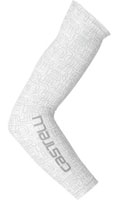
Getting sunburnt is also a common problem. Even if you don’t normally have to worry about protecting your skin, this may change when you’re outside all day for multiple days in a row. You should bring some strong sunblock in a small tube which you can refill when necessary from grocery stores along the way. Sunscreen with SPF 15, 30 or above is recommended, but see this page to understand what these numbers mean and why they are non-linear. Sweat gradually diminishes the effectiveness of sunblock, even for versions marked as waterproof, so regular re-applications may be needed.
Remember that it is the height of the sun in the sky and the amount of cloud cover that determines how quickly you will burn, the air temperature has no direct effect, so start applying sunblock mid-morning even if the temperature isn’t yet very high. Many riders also get severely damaged lips from the sun, so bring some lip balm that is specifically made to protect from the sun and make a habit of applying it regularly so that you don’t arrive at the finish with the same large sores on your lips that I and many other riders have had.
You might also consider using lightweight arm covers like the Castelli Chill Sleeves (shown on the right) to give sun protection. I find these to be more comfortable to wear in moderate heat than coating my arms in sunblock. They are reasonably popular in supported ultra-distance bike races like RAAM, but are quite rarely seen in unsupported races, but I’m not sure why that difference exists.
Dehydration can be an issue if the weather is very hot (read more at WebMD.com). You can never be sure about how frequently you’ll find re-supply points, so you should have the capacity to carry at least 1.5 liters of fluid with you and refill whenever possible (see the Water Storage Options page). I actually carry three 1-litre bottles, but only fill them all when I’m not sure where the next re-supply will be, before starting a long night ride when many services will be closed, or if I set a goal to ride a specific section without needing to stop for several hours.
Cramps tend to occur more often during prolonged extra-hard efforts, and less often during the steady, sustained pace that most ultracyclists use, but cramping is certainly possible. There is little agreement as to exactly what causes cramps, although dehydration and electrolyte deficiencies have traditionally been blamed, which are things that you should already be trying to manage. For more detailed information, see the article at ultracycling.com. Even if it doesn’t cause cramps, dehydration has been clearly proven to reduce cycling power significantly, so staying well hydrated will help you to ride faster.
On hotter days, it makes sense to avoid the hottest part of the day as much as possible. You can spend some of the middle of the afternoon eating and resting, getting prepared to ride later into the cooler evening and night air (this is also discussed in the Weather subsection of the Schedule & Goals page).
Another way to avoid the heat is that the air temperature typically reduces by about 0.65°C for every 100 meters of elevation gain. This can vary widely based on local factors, but if you climb 500 meters then it should be about 3°C cooler, which can be a significant relief. Therefore, if you know that some sections of your route will be spent at higher elevations then try to plan your day around being at those higher elevations during the middle of the day and extend your stay at that elevation by having a food break there if possible.
Off-Bike Clothing for Bikepacking Races
The waterproof overshorts that I use in heavy rain can also be used as off-bike clothing if I stop at a hotel early and want to go out to dinner after getting cleaned up. Having a second pair of socks also helps in these situations, plus using MTB-style shoes that are easy to walk in. The only additional items that I need to take to have a complete off-bike outfit are a very lightweight t-shirt and some basic underwear, both of which double as sleepwear when needed.
Last significant page update: November, 2016

This is the final page in the Rider Comfort section, which is in Ride Far, Part I: The Rider.
